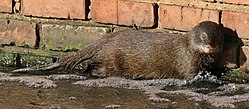| Marsh mongoose | |
|---|---|
 | |
| Scientific classification | |
| Kingdom: | Animalia |
| Phylum: | Chordata |
| Class: | Mammalia |
| Order: | Carnivora |
| Family: | Herpestidae |
| Subfamily: | Herpestinae |
| Genus: | Atilax |
| Species: | A. paludinosus |
| Binomial name | |
| Atilax paludinosus G. Cuvier, 1829 | |
 | |
The marsh mongoose (Atilax paludinosus), also called water mongoose, [1] [2] is a medium-sized mongoose species native to sub-Saharan Africa that inhabits freshwater wetlands. It has been listed as a Least-concern species on the IUCN Red List since 2008. [1]
